 Image search results - "penis" Image search results - "penis" |

Kanayama Jinja Shrine is a small shrine within the grounds of the Wakamiya Hachimangu Shrine near Kawasaki Daishi Station. On the first Sun. of April, it holds this now-famous Kanamara Festival nicknamed the Phallus or Fertility Festival. Festival starts at 11 am. But a large crowd was already there well before that time. Entrance to shrine on the day of the Kanamara Festival. (If you're below age 18, please leave now.)
|
|

Shrine banners and cherries in full bloomThe red banner says "Kanayama Jinja" with an phallus (erect) logo on the top.
|
|

Pumping (or humping) the...
|
|

The festival is wildly popular with people from overseas.The shrine had various phallus props to pose with.
|
|

Dickhead hat. Actually, I don't know what they call it, but that's what I call it.
|
|

Carving daikon. Anybody can join in and carve. 大根削りLater to be auctioned off.
|
|
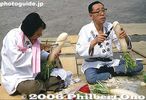
Carving daikon (old photo). These men were really good at carving the daikon.
|
|
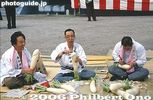
Carving daikon. Since some activities are conducted on the ground, the festival is also called Jibeta (Ground) Matsuri.Once upon a time, the festival was still mostly a local event with much fewer people.
|
|
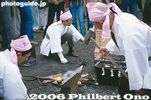
Forging a steel phallus (old photo)The demon living in the vagina of the women bit the man's phallus each time. So one guy made a steel phallus and the demom broke his teeth.
|
|

Standing room only at Wakamiya Shrine
|
|

Way to Tagata Shrine from Tagata Jinja-mae Station. Shrine famous for numerous phallic objects used as offerings to the gods. The 1500-year-old shrine worships a deity called Tamahime-no-Mikoto who was a daughter of a powerful local lord from the 5th c.The Honen-sai or Honen (Hounen) Matsuri is held by Tagata Jinja on March 15 to pray for an abundant harvest. "Honen" literally means "Year of abudant harvest." Since a giant penis is used as an offering, it is popularly called the "penis festival."
The shrine is near Tagata Jinja-mae Station on the Meitetsu Railways' Komaki Line. From Shin-Nagoya Station or Shin-Gifu Station, go to Inuyama Station and transfer to the Komaki Line.
|
|

Packed path to Wakamiya Hachimangu Shrine
|
|

Festival spectators come by the busload, including people from US military bases such as Yokota.
|
|

Prayers to the Kanamara Boat portable shrine かなまら舟神輿 神輿御霊入れ式Before the portable shrine is taken out to be paraded around town, the god of the shrine must be transferred to it. This is what the head priest is doing.
There are three portable shrines (called mikoshi). The Kanamara mikoshi (the original portable shrine), Kanamara-bune mikoshi (shaped like a boat), and Elizabeth mikoshi (pink giant). All three are carried during a procession around town. The Elizabeth mikoshi is carried by she-males. ("New half" in Japanese. Go ahead and laugh if you want.)
|
|

Entering Tagata Shrine, dedicated to Tamahime-no-Mikoto (daughter of a local feudal lord) and Mitoshi-no-Kami (deity of harvests).
|
|

Prayers to the Kanamara-bune mikoshi かなまら舟神輿Before the portable shrine is taken out to be paraded around town, the god of the shrine must be transferred to it. This is what the head priest is doing.
|
|

Various entertainment is staged within Tagata Shrine up until the procession starts at 2 pm.
|
|

The shrine's head priest transfers the deity to the Kanamara Boat portable shrine (boat-shaped loaded with a phallus) かなまら舟神輿Before the portable shrine is taken out to be paraded around town, the god of the shrine must be transferred to it. This is what the head priest is doing.
|
|

Schedule of events and procession route. In odd-numbered years (like 2007), the procession starts from nearby Kumano-sha Shrine. In even-numbered years, the procession starts from Shinmei-sha Shrine.
|
|

Tagata Shrine Honden main hall. Komaki, Aichi Pref.
|
|

A representative of the shrine parishioners offer prayers.
|
|

People line up to rub the sacred balls. Penis rock in the foreground.
|
|

Tagata Shrine Honden main hall which worships shrine worships a deity called Tamahime-no-Mikoto who was a daughter of a powerful local lord from the 5th century.
|
|

Prayers to the Elizabeth portable shrine エリザベス神輿Before the portable shrine is taken out to be paraded around town, the god of the shrine must be transferred to it. This is what the head priest is doing.
|
|

Sacred Balls. Put in money and rub the left and right ball for family safety, business prosperity, safe childbirth, etc. 珍宝窟
|
|

Torii to Oku-no-miya Shrine, next to the Honden main hall.
|
|

Waving the sacred sakaki branch to bless all of us
|
|
|

Stones and Oku-no-miya Shrine
|
|
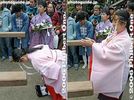
Prayers to the Elizabeth portable shrine エリザベス神輿Before the portable shrine is taken out to be paraded around town, the god of the shrine must be transferred to it. This is what the head priest is doing.
|
|

Torii gate to Kumano-sha Shrine.
|
|

Elizabeth portable shrine エリザベス神輿Before the portable shrine is taken out to be paraded around town, the god of the shrine must be transferred to it. This is what the head priest is doing.
There are three portable shrines (called mikoshi). The Kanamara mikoshi (the original portable shrine), Kanamara-bune mikoshi (shaped like a boat), and Elizabeth mikoshi (pink giant). All three are carried during a procession around town. The Elizabeth mikoshi is carried by she-males. ("New half" in Japanese. Go ahead and laugh if you want.)
|
|

Kumano-sha Shrine, the starting point of the procession or "Penis Parade." 熊野社
|
|

This is what you see inside Oku-no-miya Shrine. A giant wooden phallus offering.
|
|

Pubic hair not included. Perhaps that's why it doesn't look so obscene.
|
|

Inside Kumano Shrine. Notice the wooden penises on lower left.
|
|

Oku-no-miya Shrine also has many other phallic objects presented as offerings. There even one which you can touch...
|
|

Elizabeth portable shrine was donated by a drag queen club called Elizabeth Kaikan in Kameido, Tokyo.There are three portable shrines (called mikoshi). The Kanamara mikoshi (the original portable shrine), Kanamara-bune mikoshi (shaped like a boat), and Elizabeth mikoshi (pink giant). All three are carried during a procession around town. The Elizabeth mikoshi is carried by she-males. ("New half" in Japanese. Go ahead and laugh if you want.)
|
|

Apparently it can become erect too. (Compare with previous photo.)
|
|

Portable shrine for Takeinadane-no-Mikoto who was a local prince married to Tamahime which Tagata Shrine worships.
|
|

Kanamara Boat portable shrine (boat-shaped loaded with a phallus) was donated by a steel company. かなまら舟神There are three portable shrines (called mikoshi). The Kanamara mikoshi (the original portable shrine), Kanamara-bune mikoshi (shaped like a boat), and Elizabeth mikoshi (pink giant). All three are carried during a procession around town. The Elizabeth mikoshi is carried by she-males. ("New half" in Japanese. Go ahead and laugh if you want.)
|
|

Phallic objects
|
|

The second portable shrine and main attraction. It is 2.5 meters (13 feet) long, 60 cm diameter, and weighs about 300 kg. It takes 10 days to carve it from a cypress log.
|
|

Two of the portable shrines ready to go. In Japanese, the festival is nicknamed "Chinko Matsuri" (Phallus Festival) ちんこ祭り.There are three portable shrines (called mikoshi). The Kanamara mikoshi (the original portable shrine), Kanamara-bune mikoshi (shaped like a boat), and Elizabeth mikoshi (pink giant). All three are carried during a procession around town. The Elizabeth mikoshi is carried by she-males. ("New half" in Japanese. Go ahead and laugh if you want.)
|
|

Front view. A new giant, wooden phallus is carved every year since newly-made objects are considered to have more purity and vitality.
|
|

Note that the phallus is not the object of worship. It is an offering to the god.
|
|

The main Kanamara mikoshi かなまら神輿There are three portable shrines (called mikoshi). The Kanamara mikoshi (the original portable shrine), Kanamara-bune mikoshi (shaped like a boat), and Elizabeth mikoshi (pink giant). All three are carried during a procession around town. The Elizabeth mikoshi is carried by she-males. ("New half" in Japanese. Go ahead and laugh if you want.)
|
|

It might look light brown here, but it looks more pinkish. It is carved in winter from a hinoki cypress tree by a master artisan wearing ceremonially-purified clothing and using traditional tools.
|
|
|
|

Kanamara mikoshi かなまら神輿There are three portable shrines (called mikoshi). The Kanamara mikoshi (the original portable shrine), Kanamara-bune mikoshi (shaped like a boat), and Elizabeth mikoshi (pink giant). All three are carried during a procession around town. The Elizabeth mikoshi is carried by she-males. ("New half" in Japanese. Go ahead and laugh if you want.)
|
|

Votice tablets written with people's wishes for love, sex, and babies.
|
|

Maiden poses with the giant penis. In the past, the phallus was attached to a straw effigy of a warrior, but it was deemed too raunchy and discontinued.
|
|

Ready for the procession
|
|

Conch shell
|
|

Place to rub the sacred balls. 珍宝窟
|
|

Taiko drummers in front of Wakamiya Hachimangu
|
|

Banner with ukiyoe shunga-style painting of a penis.
|
|
|

Wakamiya Hachimangu Shrine
|
|

Another mikoshi with a wooden penis. For a good harvest.
|
|
|
|

Kanayama Shrine (right next to Wakamiya Hachimangu)Kanayama Shrine is dedicated to a pair of gods named Kanayama Hikonokami and Kanayama Himenokami 金山比古神(かなやまひこのかみ) 金山比売神(かなやまひめのかみ. According to legend, when the main Shinto god named Izanami gave birth to the God of Fire, her lower abdomen got burned. These two Kanayama gods helped to heal her birth wound. Thus, these two gods came to be known as the gods of childbirth and healing of the lower abdomen. They later came to be worshipped as fertility gods, protector of sexually-transmitted diseases (AIDS, etc.), and successful marriage. They are also the gods of the bellows, so blacksmiths (who use bellows to fan the fire) also worship this shrine.
Kanayama Shrine is a small shrine within the grounds of the larger Wakamiya Hachimangu Shrine. The Kanayama Shrine was completely rebuilt and reborn in 1999 into a completely unorthodox building which you see here. Modeled after a blacksmith's workshop, it is now a black, eight-sided building with steel paneling. Notice the penis monument on the lower right.
|
|

Nose jobI didn't see this among the souvenirs being sold. Wonder where he got it.
|
|

Rub the two balls.
|
|

Penis prayersThis penis monument (built in 1995 by a steel company) is next to Kanayama Shrine. This person praying is a Caucasian man, not a woman. I was aghast when he stood up and showed his manly face. His long blond hair made me think he was a woman...
|
|

Procession maidens pose with wooden penises. Tagata Shrine Honen Festival
|
|

Put in money and it will make a "chin" sound. (From the word "chinpo" for penis.)
|
|

Licking it...Look at that tongue...
|
|

Procession maidens pose with wooden penises.
|
|

Phallic fence posts.
|
|

Riding it...Obviously I have better shots of her with her cute face showing and both arms in the air, but I'm not one to embarass people...
It has been scientifically proven that sex is good for your health and beauty.
|
|
|
|
|

Ooohhh, ecstasy...Nah, just joking. She was actually just embarassed and spontaneously covered her face with a giggle. Obviously I have better shots of her with her cute face showing, but I'm not one to embarass people... Boy, I wish I took a video clip of this scene.
Actually, what happened is that a guy sat on this black penis before she did, and she saw that. So she imitated and sat on it too. Her female friend was taking her picture. Later they switched places and her friend, who was wearing a skirt and red net stockings, sat on it and posed for pictures.
Notice the zigzag white paper streamers. They indicate something which is sacred. So this penis is sacred, possessing a divine spirit. I can believe this because it draws so many people to it. It definitely has divine power. I mean it made this girl sit on it right?
|
|
|

Phallic rock. There are several phallic rocks donated by various people. Apparently they are either natural or carved.
|
|

Inside Kanayama Shrine 金山神社Kanayama Shrine is dedicated to a pair of gods named Kanayama Hikonokami and Kanayama Himenokami 金山比古神(かなやまひこのかみ) 金山比売神(かなやまひめのかみ. According to legend, when the main Shinto god named Izanami gave birth to the God of Fire, her lower abdomen got burned. These two Kanayama gods helped to heal her birth wound. Thus, these two gods came to be known as the gods of childbirth and healing of the lower abdomen. They later came to be worshipped as fertility gods, protector of sexually-transmitted diseases (AIDS, etc.), and successful marriage. They are also the gods of bellows (you can see it on the left of the fireplace above), so blacksmiths (who use bellows to fan the fire) also worship this shrine.
|
|

Lots of people pose with the giant penis. Amid hordes of amateur photographers
|
|

Best-looking phallic rock.
|
|

Inside Kanayama ShrineKanayama Shrine is dedicated to a pair of gods named Kanayama Hikonokami and Kanayama Himenokami 金山比古神(かなやまひこのかみ) 金山比売神(かなやまひめのかみ. According to legend, when the main Shinto god named Izanami gave birth to the God of Fire, her lower abdomen got burned. These two Kanayama gods helped to heal her birth wound. Thus, these two gods came to be known as the gods of childbirth and healing of the lower abdomen. They later came to be worshipped as fertility gods, protector of sexually-transmitted diseases (AIDS, etc.), and successful marriage. They are also the gods of bellows, so blacksmiths (who use bellows to fan the fire) also worship this shrine.
|
|

Many foreigners also join in the fun. The giant phallus was originally about 1 meter long and paraded by itself by 4-5 people with no portable shrine shelter.
|
|
|

Inside Kanayama Shrine
|
|

Procession maidens pose with the giant penis. The giant phallus was then partially hidden by the portable shrine as it is today. But this made the phallus become larger to 2.5 meters, as if to compensate for this partial shielding.
|
|

Female and male rocks.
|
|

Painting inside Kanayama Shrine
|
|

Palanquin maidens.
|
|

Behind the rocks are two trees bonded together.
|
|

Kanayama Shrine altarFlanked by penis statues on the left and right.
|
|

Gozensai ceremony before the start of the procession.
|
|

Kanayama Shrine altar
|
|

Gozensai prayer ceremony before the start of the procession.
|
|

Kanayama Shrine altar offeringsNotice the male and female mochi offering.
|
|

Gozensai ceremony before the start of the penis procession. Tagata Shrine Honen Matsuri
|
|

The short prayer ceremony ends.
|
|

Shrine maiden
|
|

Mikoshi (portable shrine) bearers gather in front of Kumano Shrine.
|
|

Worst-looking phallic rock. That's stretching the imagination a little too much.
|
|

Giving offerings inside Kanayama Shrine
|
|

Sake
|
|

Inside Kanayama Shrine
|
|

Breaking the sake barrel
|
|

Phallic souvenirs.
|
|

The old Kanayama ShrinePicture was taken in the 1980s.
|
|

Sake flows freely.
|
|

The old Kanayama Shrine
|
|

People waiting for the procession along the shrine steps. (Not a good place to watch the procession.)
|
|

The old Kanayama Shrine
|
|

People waiting for the procession in front of Kumano Shrine.
|
|

Prayers for a child written on these votive tablets (ema)
|
|

Men in happi coats which read "Honen Matsuri." Honen literally means "year of abundant harvest."
|
|

Shack for votive tablets
|
|

The procession is ready to start from Kumano Shrine.
|
|

Roof ridge emblem
|
|

People waiting for the procession in front of Kumano Shrine.
|
|

Blacksmith's tool
|
|

Sarutahiko-no-Okami, the deity who led the descent of Amaterasu (Sun Goddess) from heaven to earth.
|
|

Another phallus near Kanayama ShrineIt was pretty lonely, with no one paying attention to it.
|
|

The procession goers down the slope in front of Kumano Shrine.
|
|

Happi coat with official logo
|
|

The first mikoshi is for Takeinadane-no-Mikoto coming to visit his wife of Tamahime at Tagata Shrine, where Tamahime's residence was located.
|
|

Lollipop, lollipop, oh lolly-lollipop (pop!)...From an old song. These lollipops were selling like hotcakes.
|
|

Takeinadane-no-Mikoto
|
|

Free amazake (sweet sake). It's a white, creamy liquid served with small dried fish with wiggly tails. Sort of reminds you of something...Sperm!
|
|

The second mikoshi features the giant penis carried by 12 men at a time, all of whom are age 42, considered to be an unlucky age (yakudoshi) for men. They seek protection by carrying the phallus.
|
|

The crowd awaits the departure of the portable shrines to go on the procession around town.
|
|

The giant phallus by itself weighs about 280 kg (620 lbs.). The total weight of both the phallus and portable shrine housing is 400 kg (885 lbs.).
|
|

People could borrow and wear kimono for free, courtesy of the shrine.The portable shrine procession is actually called a "costume parade." You can wear a mask or whatever and also wear a kimono (considered to be a costume) and join in the parade.
|
|

The giant phallus is called "O-owasegata." It is an offering, and not a deity nor object of worship. Tagata Shrine Honen Festival. A total of 60 men take turns carrying the giant phallus portable shrine. 大男茎形
|
|

The Kanamara boat mikoshi is the first to leave. 神輿の巡幸
|
|

Next is a palanquin (not mikoshi) for the Toshi-gami deity of harvests. 御歳神
|
|

The Kanamara boat mikoshi is the first to leave.
|
|

Toshi-gami deity of harvests is pulled on a palanquin instead of being carried.
|
|

Kanamara boat mikoshi
|
|

Toshi-gami deity of harvests.
|
|

Phallus in the Kanamara boat mikoshi
|
|
|
|

The outlandish Elizabeth mikoshi carried by she-males.
|
|

Where the penis goes, the crowd follows.
|
|
|
|
|

The Elizabeth mikoshi pumping up and down as it makes it way to town
|
|

Also see the video at YouTube. Honen-sai Festival, Tagata Shrine Honen Festival.
|
|

The main Kanamara mikoshi leaves last.
|
|

They spin around the phallus.
|
|

Kanamara mikoshi
|
|

Maidens who are 36 years old, carry wooden penises for protection during their "unlucky age" (yakudoshi).
|
|

Kanamara mikoshi
|
|
|
|

Kanamara mikoshi salutes the Wakamiya Hachimangu Shrine
|
|

Portable shrine for Takeinadane-no-Mikoto
|
|

Kanamara mikoshi salutes the Wakamiya Hachimangu Shrine
|
|
|
|

And it leaves the shrine.
|
|

The route is short, but it's a slow procession with many short breaks. The procession lasts 1.5 hours.
|
|

Heading out to the torii gate 神輿の巡幸
|
|

Takeinadane-no-Mikoto
|
|

Heading out of the shrine (old photo)This picture was taken in the 1980s.
|
|

The first half of the route is quite narrow.
|
|
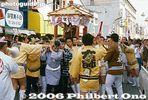
Old photoThis picture was taken in the 1980s.
|
|

Sake cart
|
|

The red cloth is the blood after the demon inside the vagina bit the phallus (Old photo)This picture was taken in the 1980s.
|
|

Salt sprinkler heads the procession to purify the way.
|
|

Portable shrine procession 神輿の巡幸
|
|

Sarutahiko-no-Okami, the deity who led the descent of Amaterasu (Sun Goddess) from heaven to earth.
|
|

Portable shrine procession
|
|
|

Art work on the cart
|
|

Branches of the sacred sakaki tree.
|
|

Portable shrine procession
|
|

Not sure what this is.
|
|

Head of the portable shrine processionTengu, shrine priest, and a little girl with an offertory tray. I put in 10 yen, and a shrine maiden came up to me and waved the sacred branch over my head as a blessing. She also gave me an amulet made of paper. I guess I'm fertile now...
|
|
|
|

Tengu (nose is not shaped like a phallus)
|
|

Drum
|
|

Kanayama Shrine's head priest
|
|
|
|

Portable shrine procession
|
|

Finally on the main road to Tagata Shrine. Half the road is blocked off for the procession.
|
|

Kanamara boat mikoshi
|
|

On the main road.
|
|
|
|

They are shouting, "Dekkai-mara Dekkai-mara" which probably means "huge phallus."
|
|
|
|

Elizabeth mikoshi carried by she-males
|
|

By this time, all the men are filled with sake and gregarious.
|
|

Elizabeth mikoshi carried by she-males
|
|

Entrance to Tagata Shrine crowded with people waiting for the procession to arrive.
|
|

She-male (or maybe just a drag queen, I couldn't visually or physically confirm)
|
|

Tagata Shrine crowded with people waiting for the procession to arrive.
|
|

Entering the main shopping street
|
|

Tagata Shrine crowded with people waiting for the procession to arrive.
|
|

Elizabeth mikoshi carried by she-males
|
|

Salt sprinkler enters first.
|
|

Maid with paws...
|
|

Sarutahiko-no-Okami
|
|

Kanamara mikoshi
|
|

The standard-bearer with a banner of shunga-style penis painting.
|
|

Kanamara mikoshi
|
|

Banner of shunga-style penis painting.
|
|
|

Women spectators touch the penis for good fortune and to become fertile perhaps?
|
|

One of many daruma shops in the town.
|
|

The phallus is a symbol for themes of fertility.
|
|

Turning around at the end of the route.
|
|

Palanquin for Deity of Harvests
|
|

Back at the shrine
|
|
|
|

Ceremony back at the shrine
|
|

The giant penis also arrives at the shrine as it spins around behind the
|
|

Amulets, votive tablets, etc., for sale by the shrine.
|
|

Giant phallus makes its way to the shrine.
|
|

Male and female made of mochi (1000 yen)
|
|
|

Hula dancing at a phallus festival?? (Click photo to learn why.)Because hula can also be considered as a sexually-suggestive dance. The way they sway the hips, etc., can be sexy enough to stir up your loins...
|
|
|
|

Hula
|
|

The giant phallus in front Tagata Shrine's Honden main hall.
|
|

Hula and cherry blossoms
|
|

Portable shrine for Takeinadane-no-Mikoto
|
|

Hula and cherry blossoms
|
|
|

Hula and cherry blossoms
|
|

Portable shrine for Takeinadane-no-Mikoto enters the Honden main hall.
|
|

Hula and cherry blossoms
|
|
|
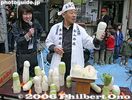
Phallus daikon radish auction, minimum bid 200 yenAll the daikon they were carving earlier in the day were sold at an auction. Most were sold for a few hundred yen. They even had an English interpreter (woman on left) so foreigners could bid too.
|
|

Now comes the giant phallus heading for the shrine's main hall.
|
|

Two for the price of one!!
|
|
|

Look, this one even has wrinkles (probably flaccid).Yes, he actually said that.
|
|

Penetration successful. This is 3:30 pm.
|
|

Not exactly a work of art, but...
|
|

Carried by men singing kiyari laborers' songs, the smaller wooden phallus also goes to enter the shrine's main hall.
|
|

Items for the auction's climax...
|
|
|
|
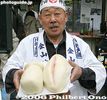
Male and female made of mochi. Both were offerings at the shrine.
|
|

Installed inside the shrine's Honden main hall, the new giant penis will replace the old one.
|
|

Now this is a work of art. Bid at least 3,000 yen please...A Japanese woman bought this, but no takers for the mochi phallus (also 3,000 yen minimum).
|
|

Tagata Shrine grounds during the Honen Festival.
|
|

Dance
|
|

Tagata Jinja banners.
|
|

Even a rock band played...They played '70s rock.
|
|

Ema votive tablet with giant penis portable shrine. 500 yen.
|
|
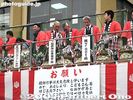
At 4 pm, the festival's final event is the mochi-nage or rice-cake tossing. First, they warn eveyone that the shrine won't be liable for any injury you might incur from this. And the elderly and children should avoid this mochi-nage.
|
|

Long line at the lollipop stand...
|
|

A large crowd tries to catch numerous mochi which are hard and can be dangerous if it hits you on the face or head. To avoid injury, do not look down and don't try to pick up mochi on the ground. You can get trampled, and most injuries occur this way.
|
|

Handmade male/female lollipops for 600 yen each
|
|

Lollipop maker, very popular
|
|

Pregnant women also attend the festival. As well as mothers with a young baby coming to give thanks.
|
|

Lollipops (mass produced)The wrapping is printed with a prayer for conceiving.
|
|
|
|